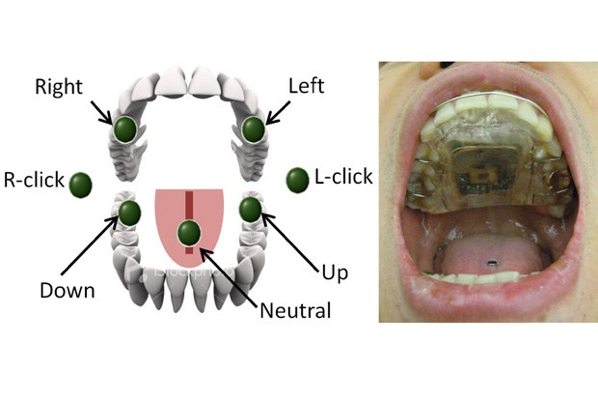Today I bring you one example of how medical technology and body modification are converging.

The image above comes from the Georgia Institute of Technology, where they have engineered a new form of wheelchair mobility through the use of a tongue piercing. The Tongue Drive System uses a dental plate that captures the movement of the tongue piercing below, which is fashioned with a tiny magnet on top. The information is then sent to an iPod Touch or iPhone, where
Software installed on the Apple device works out the relative position of the magnet with respect to the array of sensors in real time and interprets the user’s commands. This information is then used to control the movements of a cursor on the computer screen or to substitute for the joystick function in a powered wheelchair.
The team has also created a universal interface for the intraoral Tongue Drive System that attaches to a standard electric wheelchair. It holds the iPod, wirelessly receives the sensor data and delivers it to the iPod touch, charges it and features a container for leaving the retainer overnight for charging.
The system can be trained with multiple commands — unlike the common sip-n-puff device that acts as a switch controlled by sucking or blowing through a straw.

This technology is but a recent example of the (new) cyborg body. I have written before about how body modification and medical technology are changing the way we approach the human body, expanding the possibilities for prosthetics and human augmentation. For instance, I have highlighted some of the early prosthetics of the medieval period, and I have also highlighted ‘The Bionic Girl’ Chloe Holmes, who received a powerful prosthetic hand with independently articulating digits. And in terms of augmentation, I have reviewed the “Eyeborg Documentary” as an exploration of the future of human-technology augmentations.
The Tongue Drive System is but a recent example of medical technology incorporating popular body modifications into new assistive technologies, blurring the boundaries between medicalization and body modification.

Comments 2
Wisdom of the Octopi | Pearltrees — March 14, 2012
[...] The Brain-Tongue-Computer Interface can be equipped with more complex commands than many standard mobility technologies. This technology is but a recent example of the (new) cyborg body . I have written before about how body modification and medical technology are changing the way we approach the human body, expanding the possibilities for prosthetics and human augmentation. For instance, I have highlighted some of the early prosthetics of the medieval period , and I have also highlighted ‘The Bionic Girl’ Chloe Holmes , who received a powerful prosthetic hand with independently articulating digits. The Medical Benefits of Body Modification » Cyborgology [...]
MyFavoriteStyles.com — March 21, 2012
Holy cow, that's pretty neat!!